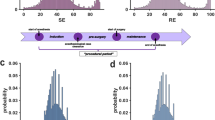Abstract
The measurement of anesthetic depth is important in anesthesiology. Although heart rate variability (HRV) is profoundly affected by general anesthesia, it has not yet been commonly used in this field. One of the reasons is the lack of suitable parameters of HRV for short-term observations. In this study, we designed a time domain parameter of HRV named the similarity index. It was based on observing the trend of the distribution of instantaneous heart rates as time moved. Taking epochs of ECG data as short as 64 s can derive the index. We observed the values of this index of 30 patients when they were awake and under isoflurane anesthesia. The values had very little overlapping between the two states and the prediction probability to distinguish the two states was 0.91. We suggest that HRV, if suitably treated, can play more roles in the monitoring of anesthetic depth.








Similar content being viewed by others
References
Akselrod S, Gordon D, Ubel FA, Shannon DC, Barger AC, Cohen RJ (1981) Power spectrum analysis of heart rate fluctuation: a quantitative probe of beat-to-beat cardiovascular control. Science 213:220–222
Al-Amgari HM, Sahakian AV (2007) Use of sample entropy approach to study heart rate variability in obstructive sleep apnea syndrome. IEEE Trans Biomed Eng 54:1900–1904
Berger RD, Akselrod S, Gordon D, Cohen RJ (1986) An efficient algorithm for spectral analysis of heart rate variability. IEEE Trans Biomed Eng 33:900–904
Bowdle TA (2006) Depth of anesthesia monitoring. Anesthesiol Clin 24:793–822
Drummond JC (2000) Monitoring depth of anesthesia. Anesthesiology 93:876–882
Fleisher LA, Pincus SM, Rosenbaum SH (1993) Approximate entropy of heart rate as a correlate of postoperative ventricular dysfunction. Anesthesiology 78:683–692
Galletly DC, Westenberg AM, Robinson BJ, Corfiatis T (1994) Effect of halothane, isoflurane and fentanyl on spectral components of heart rate variability. Brit J Anaesth 72:177–180
Griffin MP, Lake DE, Bissonetle EA, Harrell FE, O’Shea TM, Moorman JR (2005) Heart rate characteristics: novel physiomarkers to predict neonatal infection and death. Pediatrics 116:1070–1074
Ibrahim A, Taraday J, Kharasch E (2001) Bispectral index monitoring during sedation with sevoflurane, midazolam, and propofol. Anesthesiology 95:1151–1159
Kamath MV, Fallen EL (1993) Power spectral analysis of heart rate variability: a noninvasive signature of cardiac autonomic function. Crit Rev Biomed Eng 21:245–311
Kato M, Komatsu T, Kimura T, Sugiyama F, Nakashima K, Shimada Y (1992) Spectral analysis of heart rate variability during isoflurane anesthesia. Anesthesiology 77:669–674
Katoh T, Suzuki A, Ikeda K (1998) Electroencephalographic derivatives as a tool for predicting the depth of sedation and anesthesia induced by sevoflurane. Anesthesiology 88:642–650
Koskinen M, Seppanen T, Tong S, Mustola S, Thakor NV (2006) Monotonicity of approximate entropy during transition from awareness to unresponsiveness due to propofol anesthetic induction. IEEE Trans Biomed Eng 53:669–675
Kurita T, Doi M, Katoh T, Sano H, Sato S, Mantzaridis H, Kenny G (2001) Auditory evoked potential index predicts the depth of sedation and movement in response to skin incision during sevoflurane anesthesia. Anesthesiology 95:364–370
Lefoll-Masson C, Fermanian C, Aime I, Verroust N, Taylor G, Laloe PA, Liu N, Aegerter P, Fischler M (2007) The comparability of bispectral index and state entropy index during maintenance of sufentanyl-sevoflurane-nitrous oxide anesthesia. Anesth Analg 105:1319–1325
Malik M, Camm AJ (1993) Components of heart rate variability––what they really mean and what we really measure. Am J Cardiol 72:821–822
Myers GA, Martin GJ, Magid NM, Barnett PS, Schaad JW, Weiss JS, Lesch M, Singer DH (1986) Power spectral analysis of heart rate variability in sudden cardiac death: comparison to other methods. IEEE Trans Biomed Eng 33:1149–1156
Richman JS, Moorman JR (2000) Physiological time-series analysis using approximate entropy and sample entropy. Am J Physiol Heart Circ Physiol 278:H2039–H2049
Rosow C, Manbery PJ (2001) Bispectral index monitoring. Anesthesiol Clin North America 19:947–966
Schneider G, Hollweck R, Ningler M, Stockmanns G, Kochs EF (2005) Detection of consciousness by electroencephalogram and auditory evoked potentials. Anesthesiology 103:934–943
Smith WD, Dutton RC, Smith NT (1996) Measuring the performance of anesthetic depth indicators. Anesthesiology 84:38–51
Task Force of the European Society of Cardiology, The North American Society of Pacing and Electrophysiology (1996) Heart rate variability, standards of measurement, physiological interpretation, and clinical use. Circulation 933:1043–1065
Zochowski M, Winkowska-Nowak K, Nowak A, Karpinski G, Budaj A (1997) Autocorrelation of R–R distributions as a measure of heart variability. Phys Rev E 56:3725–3727
Author information
Authors and Affiliations
Corresponding author
Rights and permissions
About this article
Cite this article
Huang, HH., Lee, YH., Chan, HL. et al. Using a short-term parameter of heart rate variability to distinguish awake from isoflurane anesthetic states. Med Biol Eng Comput 46, 977–984 (2008). https://doi.org/10.1007/s11517-008-0342-y
Received:
Accepted:
Published:
Issue Date:
DOI: https://doi.org/10.1007/s11517-008-0342-y




